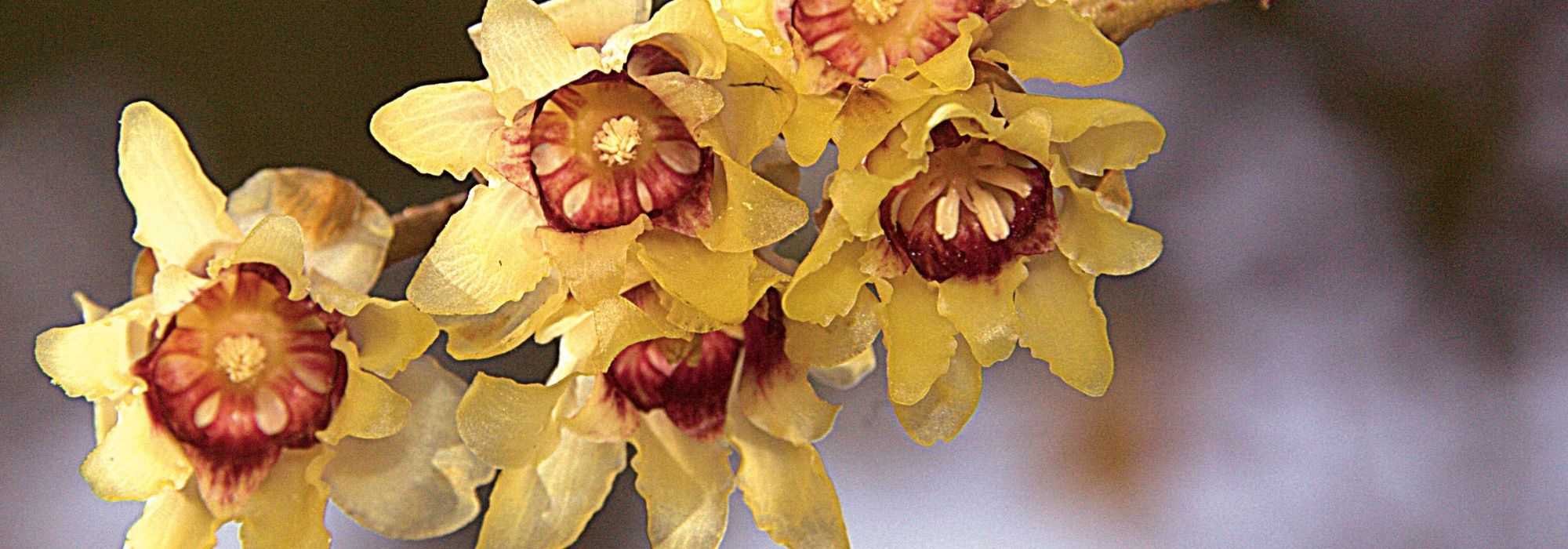
Chimonanthe, Chimonanthus praecox<em> </em>: planting, cultivation, pruning
Contents
Wintersweet
- Early chimonanthe, known as fragrant chimonanthe, is one of the most scented bushes in the garden: its flowering literally perfumes the air!
- In winter, it bears vivid purplish-yellow flowers with an intense fragrance that stud the naked wood
- Its green leaves in spring turn to golden yellow in autumn
- It thrives in any type of soil that is not too dry
- Hardy, it is suitable for all gardens, including seaside ones, and can be planted as a flowering hedge, in beds or in containers
A word from our expert
Chimonanthus, wintersweet (Chimonanthus praecox, syn. Chimonanthus fragrans) or fragrant chimonanthus is a winter-flowering bush still too little known. In the heart of winter, the chimonanthus flower appears on shoots still bare. Sulphur-yellow touched with purplish red, intensely fragrant, its flowering brightens the bleak season. Its deciduous foliage also provides a display in autumn by turning golden.
If other Chimonanthus species exist, such as Chimonanthus campanulatus, only Chimonanthus praecox and its varieties such as ‘Grandiflorus’, with slightly larger flowers and mahogany centres, are available in our French nurseries.
Hardy, accommodating and very easy to grow, it thrives in full sun or partial shade and will grow in any well-drained soil. From planting to layering, preferable to taking cuttings, we reveal everything about this handsome, highly fragrant bush.
Once well established in suitable conditions, this bush requires little maintenance; chimonanthus seed may even self-sow!
With its unusual flowering, chimonanthus creates attractive focal points in borders, in a flowering hedge or in a pot on a patio to fully enjoy its fragrance.
Discover this little-known bush that scents the garden for tens of metres around as well as our unique selection of fragrant bushes!
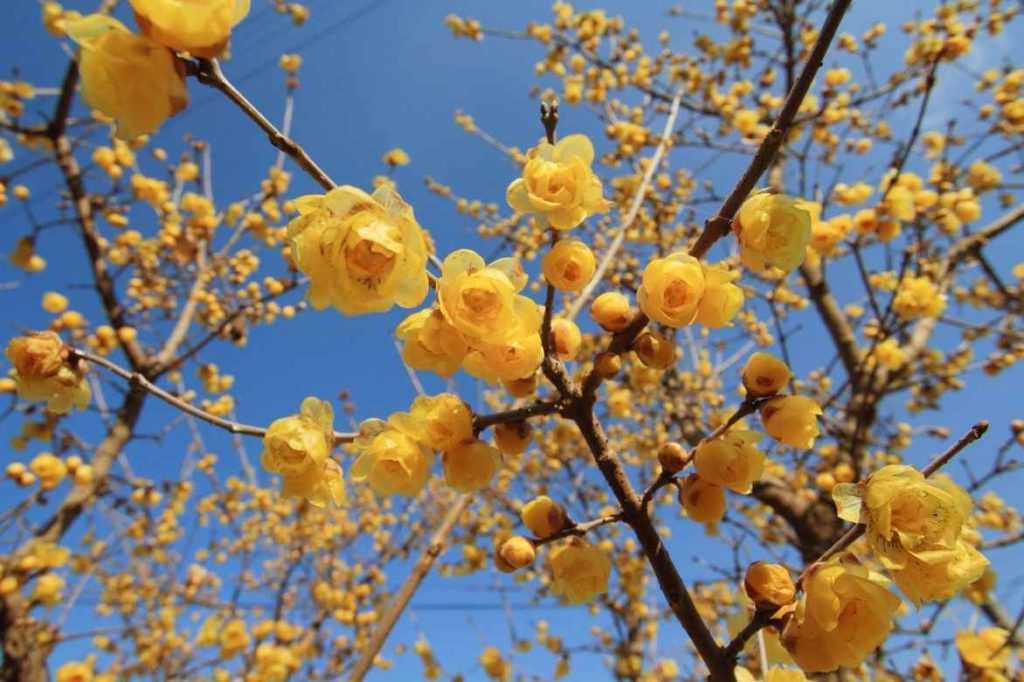
Description and botany
Botanical data
- Latin name Chimonanthus, Chimonanthus praecox
- Family Calycanthaceae
- Common name Chimonanthe, wintersweet
- Flowering November to February
- Height 1.5 to 5 m
- Sun exposure sun, partial shade
- Soil type all, moist
- Hardiness -15°C
Chimonanthe, or wintersweet (Chimonanthus praecox) is a bush of the family Calycanthaceae, native to China, where it grows in montane woods between 500 and 1,100 m.
The genus Chimonanthus includes six species of bush, most often evergreen (Chimonanthus campanulatus, Chimonanthus grammatus, Chimonanthus nitens), but also Chimonanthus praecox (syn. Chimonanthus fragrans), which is deciduous and is the only species commonly grown in our climate.
Of fairly slow growth, Chimonanthe forms a rounded bush made up of erect, ramified stems, arched at the tips. As tall as wide, it reaches on average 2 to 4 m in every direction at maturity in our gardens.
Chimonanthus praecox is a bush prized for its winter flowering and extremely fragrant flowers appearing on the still bare branches.
Beyond the Channel, it is nicknamed “wintersweet” — literally “winter sweetness” — so warming is its bloom to the garden still asleep in the cold; indeed in Greek its name means “flower of winter”. Its intoxicatingly scented flowers are remarkable because they appear in the middle of winter, from November in southern France and up to March depending on region and climate mildness. A scented flowering that will reward patient gardeners since wintersweet takes several years to flower, between five and ten years of cultivation before producing its first blooms.
The flowers, shaped like small pendulous bells 2.5 to 3 cm long and made up of 15 to 27 tepals, stud the bare wood. Waxy and translucent, they are
With Hamamelis, Daphne and Sarcococca, it is one of the few scented shrubs in winter.
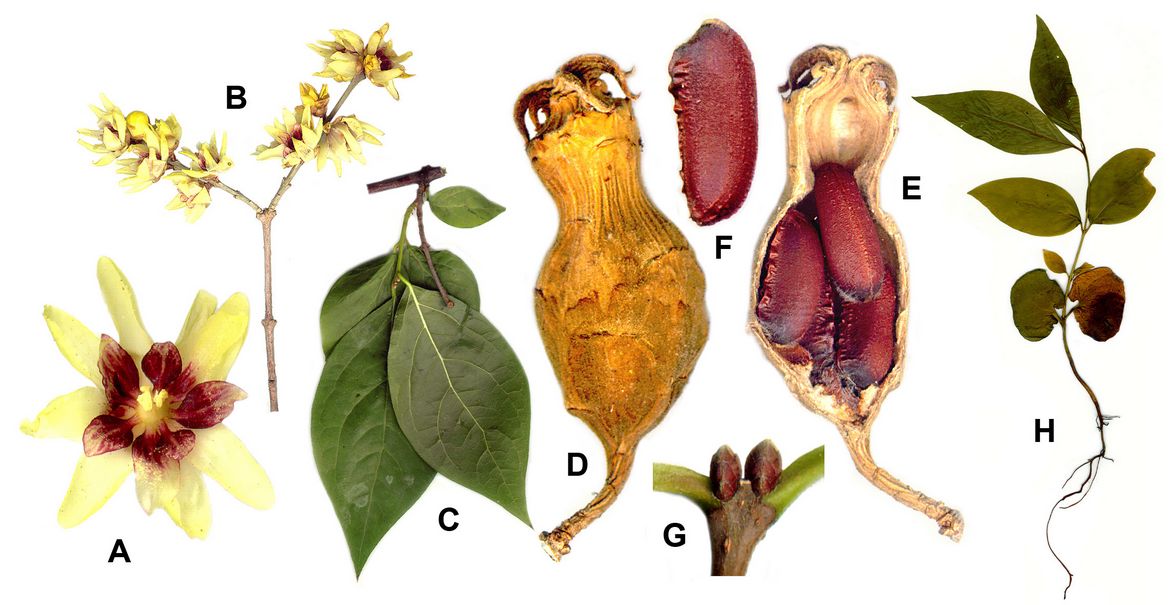
A & B flowers; C leaf; D fruit containing seeds; E longitudinal section of the fruit; F seed; G buds; H young shoot (Mihailo Grbić – Arboretum Beograd)
Its flowers literally scent the air, giving off a floral, spicy fragrance reminiscent of hyacinth, narcissus, orange zest and honey. Although fairly small, their profusion, warm tones and intense aromas warm the winter.
You can even make graphic winter bouquets with its branches still in bud, which will open earlier to scent your home.
The flowers turn into pubescent fruits shaped like small elongated pears about 4 cm long containing seeds that can be toxic.
On stiff, angular branches, a generous deciduous foliage unfolds at the shoot tips just after the flowers and is of interest. Long leaves 7 to 15 cm, single, opposite, oblong to elliptical with pointed lamina have a rough texture and paler veins. This usually mid-green, mostly leathery foliage, very rarely golden in some cultivars, takes sumptuous golden-yellow tones in autumn before falling.
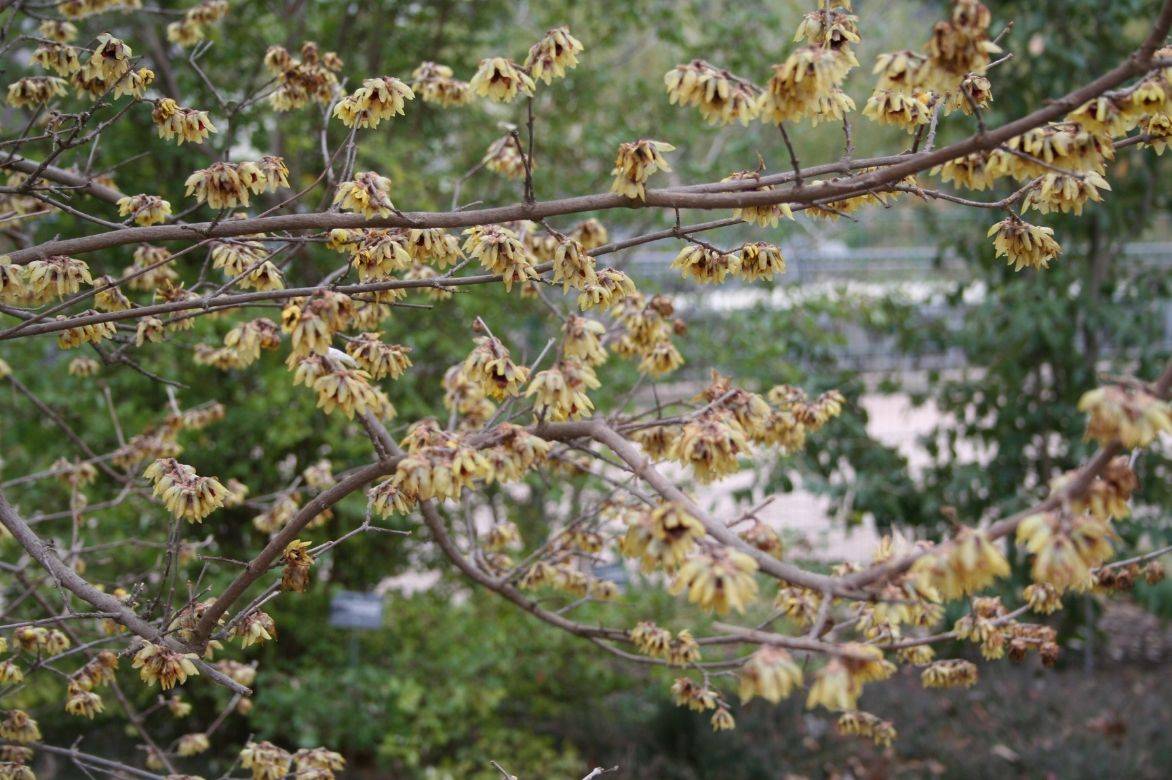
Magnificent display of Chimonanthus praecox, all the more striking because it blooms in winter
Chimonanthe praecox is hardy and withstands winters down to -15°C. While it can be grown throughout France, it is easier to cultivate in oceanic regions where summers are warm and humid. Less demanding than Hamamelis, it accepts any fertile, moist, well-drained soil, even slightly calcareous. It is planted in sun or light shade and should be sheltered from cold winds and late frosts that can damage its very early flowering.
It can be installed in the ground as a solitary specimen or in a mixed border. Its slow growth allows container culture, so you can enjoy its scent on a terrace or near entrances.
Roots and bark of Chimonanthus praecox are used in Chinese medicine to treat rheumatism.
Read also
10 fragrant and scented plantsMain species and varieties
In France, only Chimonanthus praecox and its few interesting varieties are available commercially for their larger, more colourful flowers or their later flowering.
Most popular
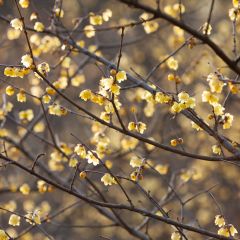
Chimonanthus praecox
- Height at maturity 2,50 m
Our favourite
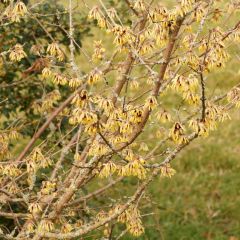
Chimonanthus praecox Grandiflorus
- Height at maturity 2,50 m
Planting
Where to plant chimonanthe?
With fine hardiness, Chimonanthus praecox can withstand temperatures down to -15 °C, so it can be grown in all regions. However, it needs long warm but humid summers to flower well and will perform better in oceanic areas or south of the Loire. A situation sheltered from strong winds and late frosts that can damage its flower buds is recommended, as this bush needs as much summer warmth as possible to flower abundantly.
Regarding soil, it is a tolerant bush that copes with any good garden soil: rich, fresh, well drained, even slightly calcareous soil. However, although it adapts easily to all soil types, it prefers fresh soils that are not too dry.
It can be planted in sun but not scorching, or even in partial shade.
It fits well into all gardens, large or small, as a specimen to create an interesting focal point, in an informal flowering hedge with other spring-flowering bushes, or in a grouped border planted in threes or fives. In very harsh climates, it can also be trained against a warm wall of the house (south- or west-facing) to shelter it from frosts, which will ensure a good flowering display.
Its slow growth allows it to be grown in a pot provided it is pruned to maintain an attractive silhouette. You can thus enjoy its scent on the terrace or near the house and its magnificent autumn colours.
When to plant chimonanthe?
Planting of early chimonanthe is preferably done in spring, from February to March, avoiding frosty periods.
How to plant chimonanthe?
In the ground
The chimonanthe prefers neutral or slightly calcareous, well-drained soil. Space them at least 1.5–2 m from other bushes.
- Dig a wide hole, wider than deep, 80 cm x 60 cm
- Loosen soil thoroughly
- Lay a layer of clay pebbles or gravel at bottom of planting hole
- Plant at collar level without burying rootball too deeply in a mix of garden soil, well-rotted compost and a handful of horn meal
- Water
- Mulch around base to keep soil cool during summer
Follow our shrub planting tips.
In a pot
- In bottom of a container at least 50 cm diameter, lay a good draining layer of gravel or clay pebbles
- Plant in a good shrub potting mix blended with compost
- Mulch around the base
- Water thoroughly
- In summer, water as soon as soil is dry
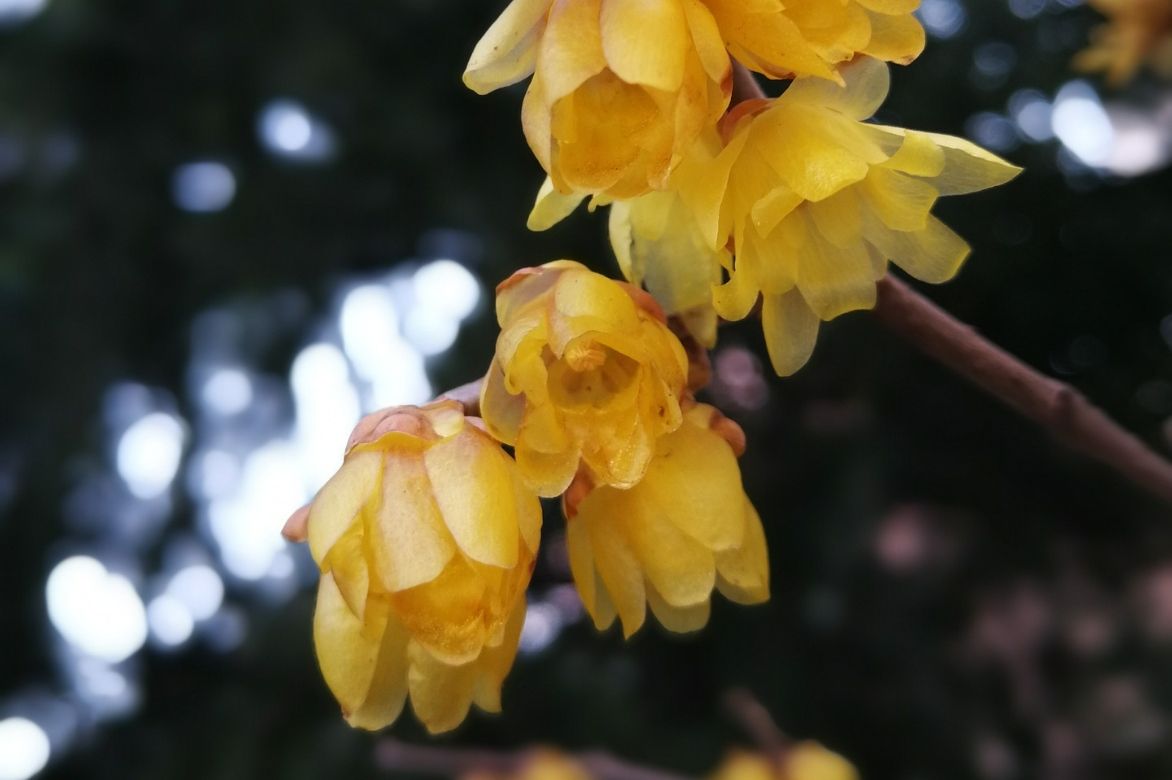
Maintenance, pruning and care
Chimonanthus requires very little maintenance. In summer, monitor water needs, and water well during hot spells; soil must never be dry. Provide mulch at base of bush before winter to protect from severe frosts and in March to keep soil cool.
Once a year in spring, if necessary, amend soil with horn meal.
You can keep a chimonanthe in a container provided you prune it each year. Remember to apply fertiliser once a year and to water well during heatwaves or prolonged drought.
When grown in suitable conditions, Chimonanthus praecox is a bush largely resistant to most diseases and parasitic pests.
Pruning chimonanthe
When and how to prune?
Pruning is not necessary. However, if you want to preserve an attractive silhouette, carry out maintenance pruning. Only intervene after flowering. This pruning is not essential every year :
- Rebalance or reduce its branches by removing crossing or thin branches
- Remove dead wood
Follow our advice on how to prune early-flowering bushes!
Propagation
Chimonanthus se multiplie facilement by layering in spring. As this bush produces fruit, sowing is possible in autumn in a cold frame, but more delicate and demanding.
Layering
Root development of Chimonanthus praecox layers is fairly slow, so be patient!
- After flowering, bend one shoot down to base of bush where it naturally touches the soil
- Remove leaves from this section of stem
- Score bark over 5–10 cm with a small knife
- Dig a furrow in the soil close to base of bush
- Lay the shoot into it and partly bury it under a mound of soil so it can take root
- Backfill the furrow and secure the layer with metal hooks (tent-peg type)
- Raise the tip and stake the aerial part
- In following spring or autumn, separate the layer from mother plant if it has sufficient roots
- Replant in chosen location
Associate
Still too little-known, the Chimonanthus odorant or Chimonanthus praecox deserves a place in winter scenes, on a par with Hamamelis. It thrives in all natural and naturalistic gardens, where its scented, colourful flowering brings a cheerful touch to garden still numbed by cold.
In a mass planting, you will make the bright colour of its flowers stand out against a permanent green backdrop made up of conifers and bushes with evergreen foliage such as Pieris, Choisya, Euonymus.
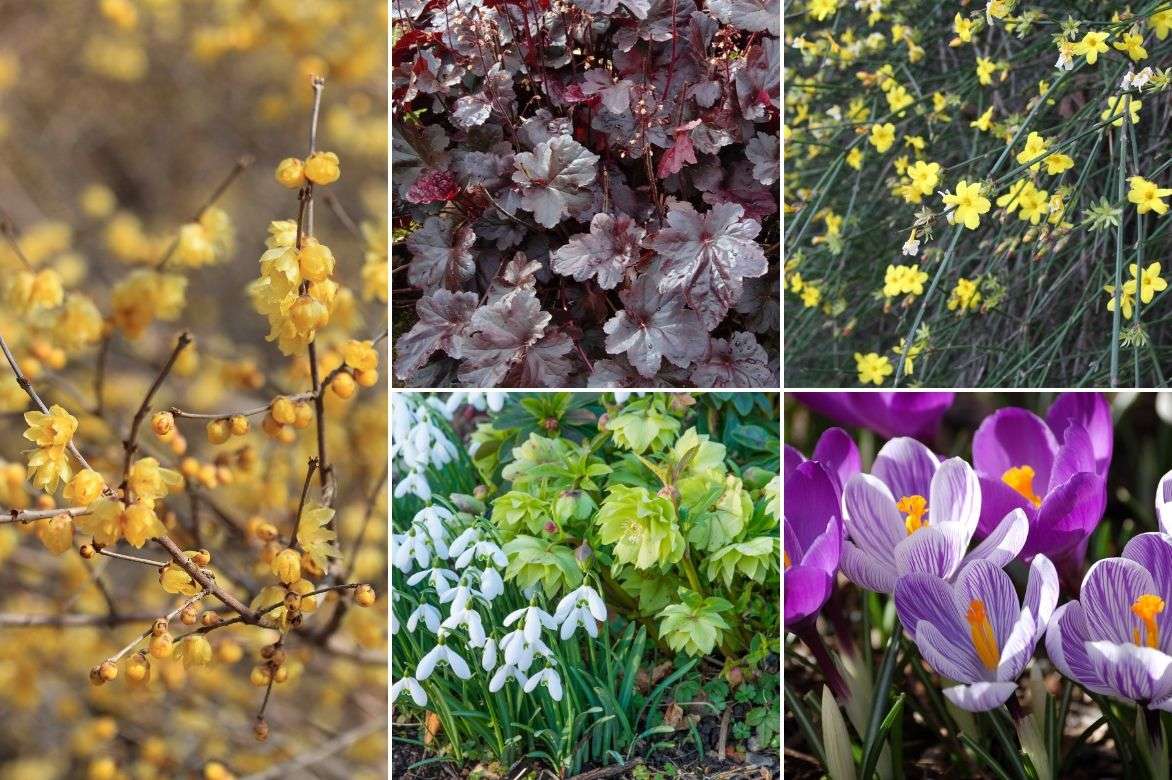
A planting idea: Chinomanthus praecox (photo TANAKA Juuyoh), Heuchera ‘Obsidian’, Jasminum nudiflorum, snowdrops and hellebores, crocus
In a scented composition at heart of winter, surround it with Daphnes, Sarcococcas or Camellias.
In a loose, flowering hedge it can be paired with bushes with winter flowering such as Hamamelis or spring-flowering ones such as Forsythia, Magnolia, Japanese quince, Kerria japonica or Edgeworthia or paperbush.
Its golden flowers will offer a striking contrast with blue of early small spring bulbs such as Muscari azureum, crocus, hyacinths, ipheions or scillas, erythroniums.
Magnificent at heart of winter, after flowering, chimonanthe will take on a rather unassuming appearance before bursting into colour again in autumn, so do make sure to surround it well! Perennials with winter flowering, winter heathers, Hellebores then Vinca minor will dress its base, while Heucheras and heucherellas will accompany its golden foliage in autumn.
In a Japanese-style zen garden, its bare twigs studded with small flowers will work wonders alongside sacred bamboos, deciduous azaleas or Japanese maples.
If you train your chimonanthe against a sunny wall, pair it with a climbing plant such as a clematis or colourful or scented annuals such as sweet pea, climbing nasturtium, Cobaea around which they will twine.
→ Discover other pairing ideas with Chimonathus in our advice sheet!
Useful resources
- How to liven up your garden during bleak months?
- Early bulbs’ flowering awakens spring, which ones will dress the base of your Chimonanthus praecox!
- Discover on our blog: most beautiful winter flowering displays
- Chimonanthus praecox, an enchanting fragrance in winter
- Subscribe!
- Contents
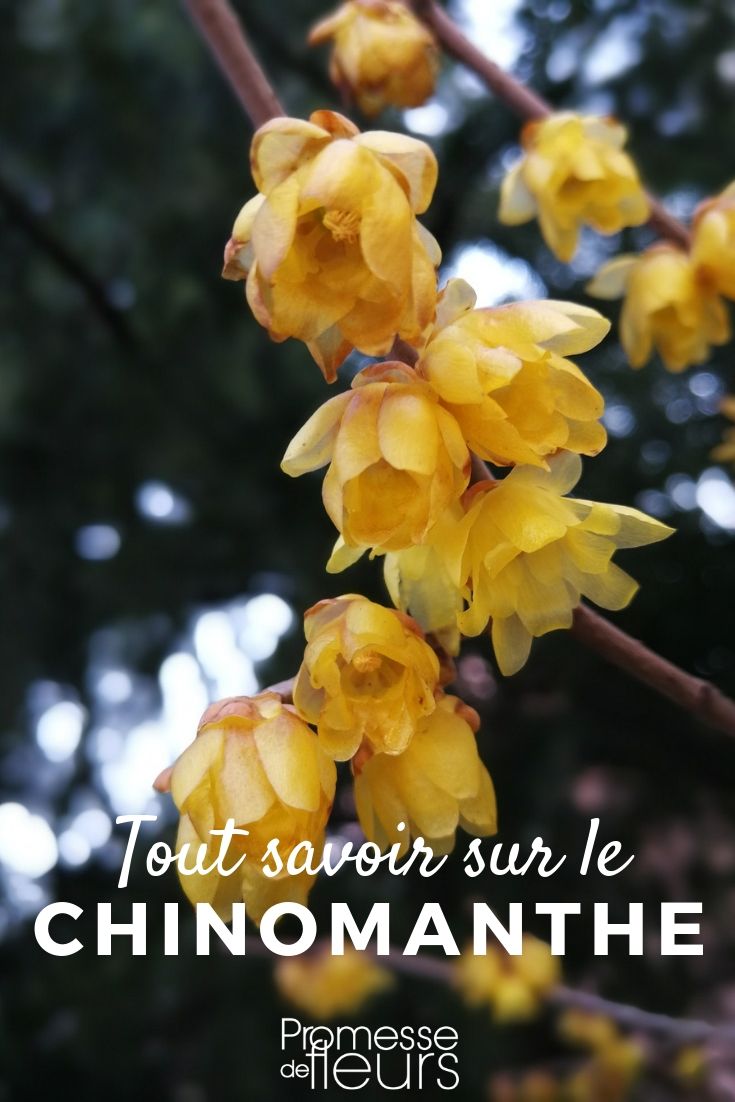































Comments